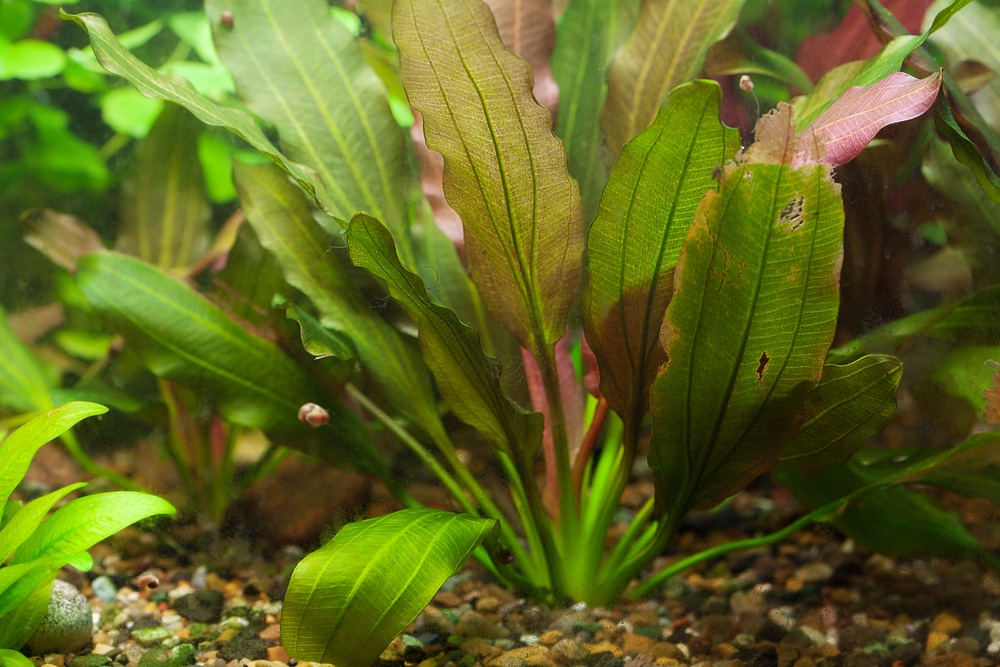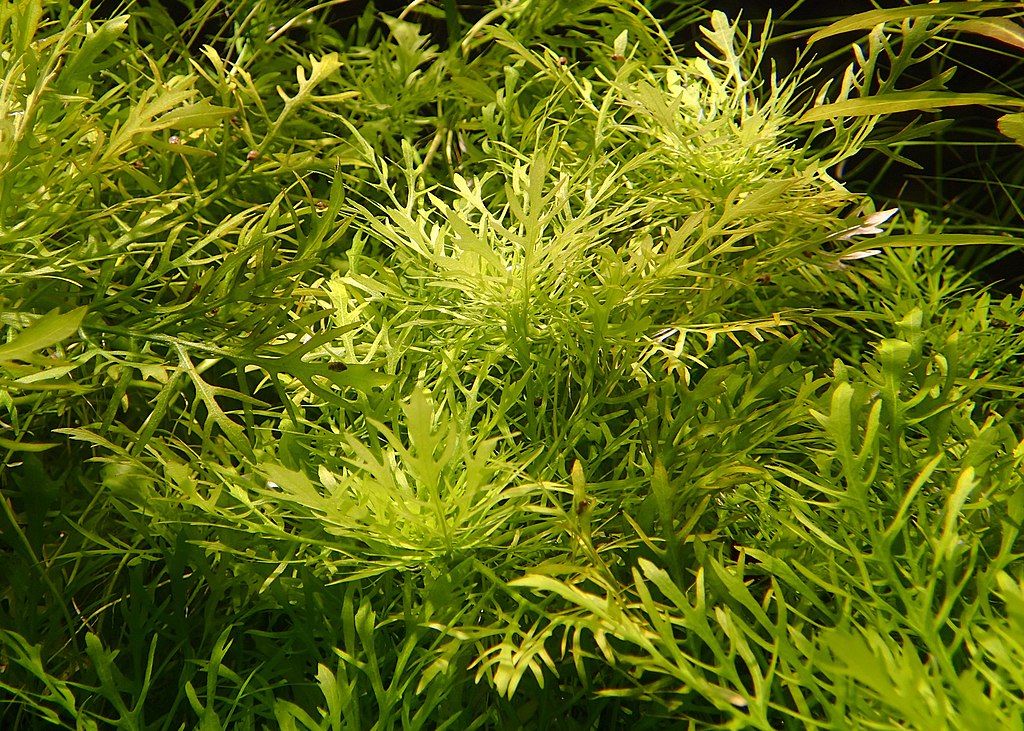In nature, Angelfish spend all of their time slipping between tightly woven weeds looking for small fish and invertebrates to eat. Planted tanks are the best environment for them as they not only help your fish feel secure but also provide the perfect place for them to spawn! With that in mind, here are some recommendations for plants for an Angelfish tank!
10 Of Our Favorite Angelfish Plants
Here are 10 of the best plants for angelfish tanks:
Amazon Sword Plant

If there’s one live plant every Angelfish keeper should use it’s Amazon Sword plants. As the name suggests they hail from the shallows of the Amazon River.
This is perfect for a South American biotope aquarium because Angelfish come from the same region. They also have similar preferences in terms of water conditions: soft, acidic water and temperatures around 80-86F.
Amazon Swords are some of the largest commonly available aquarium plants. They come in dozens of varieties but the largest can grow leaves nearly 2 feet long. You’ll have to plan your aquascape carefully to ensure your Sword Plants aren’t crowded yet don’t shade out their neighbors.
Amazon Swords are heavy feeders and appreciate a mature, enriched substrate. Red varieties need not only additional light but extra iron supplementation to maintain their ruby color.
- Scientific Name: Echinodorus grisebachii
- Origin: South America
- Height: Up to 24 inches
- Light Needs: Moderate
- Nutrition Needs: High
- Ease of Care: Moderate
Water Wisteria

Like most Hygrophila species, Water Wisteria is an easy, undemanding plant that thrives with extra light and fertilizer but can get by without.
It’s growth pattern shifts dramatically in low light conditions; the star-like fronds shrink dramatically and the plant grows wispy. The more light (and carbon dioxide – CO) you can provide, the better!
Water Wisteria is also versatile in growth habits. It can be used as a planted stem specimen, an intriguing carpeting plant, or allowed to float freely at the surface. So long as you can cater to its preference for extra light and nutrients it will grow wherever you place it.
When healthy Water Wisteria has an attractive lime green color and a fairly fast growth rate. While the leaves are too narrow for Angelfish to spawn on many of their tank mates will enjoy the thickets this plant creates.
- Scientific Name: Hygrophila difformis
- Origin: South Asia
- Height: Up to 24 inches
- Light Needs: Moderate to High
- Nutrition Needs: Moderate
- Ease of Care: Easy
African Water Fern
African Water Fern is an attractive alternative to the ever-popular Java Fern that’s catching on with a lot of aquarists looking for plants for an Angelfish tank! Like Java Fern it’s a plant that thrives in low light environments.
However this does mean that it tends to grow very slowly in most aquariums. The tradeoff is that African Water Ferns don’t need much in the way of fertilizer or CO2 supplementation.
As epiphytes they don’t uptake nutrients through roots. Instead they release holdfasts from their rhizome, which should be secured against a rock or driftwood until the plant anchors itself.
Dissolved nutrients from your fish are usually more than enough for African Water Ferns. But additional liquid fertilizers can only help speed their growth!
Once the plant grows large enough the rhizome can be split in two or three. Each section will continue sending out leaves, cloning the original for further aquascaping.
- Scientific Name: Bolbitis Heudelotii
- Origin: West Africa
- Height: Up to 10 inches
- Light Needs: Low
- Nutrition Needs: Low
- Ease of Care: Very Easy
Java Moss
If you’re a fan of the mossy jungle aquascape look, Java Moss is a must-have plant for an Angelfish tank. This is a true aquatic moss and is easily found in most pet stores as an untidy green clump.
When secured to a hard surface Java Moss eventually attaches itself and forms a loose tangle that expands to cover as much space as possible. If not kept well trimmed it will swallow up any rock or driftwood you tie it to over time.
Java Moss is a fantastic spawning bed for egg scatterers like Danios and Tetras. Livebearer fry also find it a safe haven and a sure hunting ground for infusoria and algae.
Undemanding and beautiful, Java Moss can find a place in most tanks. It grows well even in low light environments and doesn’t need additional fertilization or CO2., though these do help.
There are also several closely related Mosses in the trade that have intriguing, tidier growth habits. Some of the most common include Christmas Moss (Vesicularia montagnei) and Flame Moss (Taxiphyllum sp ‘Flame’).
- Scientific Name: Taxiphyllum barbieri
- Origin: Indonesia
- Height: 3-4 inches
- Light Needs: Low
- Nutrition Needs: Low
- Ease of Care: Very Easy
Anubias
It’s hard to think of a better plant for an Angelfish tank than Anubias. It’s hardy, thrives in low lighting conditions, prefers acidic water, and will grow nearly anywhere you place it. Like Java and African Water Fern, Anubias is an epiphyte, so it is best attached to a hard surface.
Anubias is actually a genus of several closely related species, from the tiny Anubias nana to larger varieties like A. afzelii. They tend to look quite similar to one another, with thick, dark green, teardrop shaped leaves.
When well cared for Anubias will even flower, sending a white or yellow blossom to the water’s surface on a long stalk. You’ll need to be patient with these plants as they are extremely slow growing even in the best conditions.
- Scientific Name: Anubias sp.
- Origin: West Africa
- Height: Variable
- Light Needs: Low
- Nutrition Needs: Low
- Ease of Care: Easy
Red Tiger Lotus
If you’re a fan of floating lily pads Red Tiger Lotus should be part of your aquascaping plans. Most red plants are medium to high light types. But Tiger Lotuses are lilies and send their leaves straight to the surface, ensuring they get the illumination they need.
Tiger Lotuses do like a rich substrate but otherwise don’t need much care. They are typically shipped as leafless bulbs and should never be completely buried, lest they rot. Once left partially buried and undisturbed they will quickly send new leaves to the surface.
The main downside to keeping Tiger Lotuses are the lily pads themselves. They shade out the water column beneath them, making it hard for more demanding plants to survive. Tiger Lotuses do best either in very high light tanks or paired with less light-hungry plants like Anubias or Java Moss.
- Scientific Name: Nymphaea zenkeri
- Origin: West Africa
- Height: Variable
- Light Needs: Moderate
- Nutrition Needs: Medium
- Ease of Care: Easy
Giant Hydro
Hygrophila are collectively known as “swamp weeds,” which gives you a clue as to their preferred habitat. Shallow, warm, acidic, organic-rich conditions, which Angelfish also thrive in!
Giant Hygro is one of the largest of the bunch, with broad green leaves that can grow as much as 5 inches long. Fortunately, it’s also one of the easiest to grow. While it does need at least moderate lighting Giant Hygro is otherwise undemanding and quick to take root.
If your aquarium lighting is on the lower end, you should prune the lower leaves to encourage the plant to channel growth upwards. However, with recent advances in LED lighting, it’s easier than ever to add supplemental lights to most aquariums.
Considering how wide this plant can grow make sure you provide plenty of space when planting young specimens so they don’t crowd one another as they mature.
- Scientific Name: Hygrophila corymbosa
- Origin: South America
- Height: Up to 20 inches
- Light Needs: Moderate
- Nutrition Needs: Moderate
- Ease of Care: Easy
Cryptocoryne Wendtii
Crypts are some of the easiest aquarium plants for beginners and C. wendtii is one of the best of the genus. These Sri Lankan natives are typically green or bronze and have wavy spearpoint-shaped leaves.
- wendtii thrives in both soft and hard water and does well in all lighting environments. It does prefer some fertilization and CO2 supplementation but if you don’t provide it, it’s growth rate simply slows.
Crypts do have one strange habit to take not of: Crypt melt. Occasionally, Crypt leaves will rapidly decay, sometimes down to the rhizome.
These plants hate being disturbed; once rooted they tend to decay if shifted around constantly or water conditions quickly change. So plan carefully before planting your Crypts!
All Cryptocoryne are excellent plants for an Angelfish tank. Some, such as C. balansae, grow even taller, while C. parva is one of the best carpeting plants for low light aquariums!
- Scientific Name: Cryptocoryne wendtii
- Origin: Sri Lanka
- Height: 8 inches
- Light Needs: Low
- Nutrition Needs: Low
- Ease of Care: Very Easy
Madagascar Lace Plant
Madagascar Lace Plant is one of the most beautiful plants in the trade, even competing with the showiest Amazon Swords. Their leaves have an intricate webbing and are lovely to watch wave in a slight current.
Lace Plants are on the more demanding side, preferring a rich substrate, good lighting, and some CO2 supplementation. They are show plants and should be given plenty of space to grow up and out.
Unlike most Aponogeton species the Lace Plant doesn’t have an emersed resting phase. Most Aponogeton require you to trim the remaining leaves and remove the bulb from the tank for a seasonal resting phase for a few weeks.
Lace Plants simply require a warm temperature shift (78-80F) for a few weeks before returning to their preferred range of 72-76F. Being tropical plants that prefer things a little cooler, Lace Plants do well with Danios, Barbs, and other fish that thrive in these conditions.
Just be careful not to choose fish that will nip their delicate leaves. Their leaves are also prone to algae so choose algae eaters with a light touch, such as Dwarf Otocinclus!
- Scientific Name: Aponogeton madagascariensis
- Origin: Madagascar
- Height: Up to 24 inches
- Light Needs: Moderate to High
- Nutrition Needs: Moderate
- Ease of Care: Moderate to Difficult
Moneywort
Also known as Water Hyssop, Moneywort is much better known for its use in traditional Indian Ayurvedic medicine for liver health and diabetic conditions. However it’s also a popular aquarium plant that does well alongside Angelfish!
Moneywort is versatile and undemanding. It can grow emersed or submerged and while it prefers moderate light it is one of the few stem plants that will do well in low light aquariums.
CO2 and fertilization help speed its growth but aren’t mandatory, either. Moneywort has a nice, straight growth form and looks best in small thickets.
Angelfish work well with this plant because they are easy on plants. Moneywort is fragile and both the leaves and stems break off easily. Fortunately the stems can be planted, forming a brand new plant over time!
- Scientific Name: Bacopa monnieri
- Origin: India & Southeast Asia
- Height: 10-12 inches
- Light Needs: Low to Moderate
- Nutrition Needs: Low
- Ease of Care: Easy

